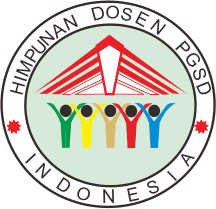Analisis kemampuan siswa dalam menyelesaikan soal matematika tipe higher order thinking skill (hots) pada materi bangun ruang kelas V sekolah dasar
Abstract
The aim of this study is to find out how students are able to solve Higher Order Thinking Skill (HOTS) type problems. This study uses a descriptive qualitative research method. The subject of this study is 17 students in grade V of SD Negeri Sambi 1. The data collection techniques used are observation, interviews, and documentation studies. The validity test of the data was carried out using triangulation techniques. The analysis technique chosen is the interactive analysis technique from Miles and Huberman with. The results of the study were that 34% of students were able to solve the problem in the first step (understanding the problem), as many as 20% of students were able to solve the problem until the second step (planning the solution), as many as 27% of students were able to solve the problem until the third step (completing the plan), in the fourth step (checking the answer again) all students were not able to complete the steps well, as many as 19% of students were not able to work using the steps to solve the problem.
Keywords
Full Text:
PDFReferences
[1] A. Djamaluddin and Wardana, Belajar Dan Pembelajaran. 2019.
[2] R. Rahayu, S. Iskandar, and Y. Abidin, “Inovasi Pembelajaran Abad 21 dan Penerapannya di Indonesia,” J. Basicedu, 6(2), pp. 2099–2104, 2022, doi: 10.31004/basicedu.v6i2.2082.
[3] J. Triyanto and S. Bayu Kurniawan, “Thematic Learning Based on Critical Thinking Skills using Blended Learning System in Elementary School,” Int. J. Elem. Educ., 6(2), pp. 305–314, 2022, [Online]. Available: https://doi.org/10.23887/ijee.v6i2.45954.
[4] W. Arsyabinta, A. Surya, and R. Winarni, “Analisis kesulitan pemecahan masalah matematika berdasarkan teori Polya pada peserta didik kelas IV sekolah dasar,” Didakt. Dwija Indria, 11(4), pp. 59–64, 2023, doi: 10.20961/ddi.v11i4.76962.
[5] K. B. Tamin, U. Ubadah, and S. Mashuri, “Tantangan Pendidikan dalam Era Abad 21,” Pros. Kaji. Islam dan Integr. Ilmu di Era Soc. 5.0 (KIIIES 5.0) Pascasarj., 1, pp. 338–342, 2022.
[6] L. Widiawati, ; Soetarno, and J. ; Sudiyanto, “Higher Order Thinking Skills as Effect of Problem Based Learning in the 21st Century Learning,” Int. J. Multicult. Multireligious Underst., 5(3), pp. 96–105, 2018, [Online]. Available: http://ijmmu.com.
[7] I. Z. Ichsan, D. V. Sigit, and M. Miarsyah, “Environmental Learning based on Higher Order Thinking Skills: A Needs Assessment,” Int. J. Educ. Vocat. Stud., 1(1), p. 21, 2019, doi: 10.29103/ijevs.v1i1.1389.
[8] Kemendikbud, “Buku Pegangan Pembelajaran Keterampilan Berpikir Tingkat Tinggi Berbasis Zonasi,” Buku Pegangan Pembelajaran Berorientasi Pada Keterampilan Berfikir Tingkat Tinggi, pp. 1–87, 2018.
[9] N. Aji, C. Chumdari, and K. Karsono, “Analisis soal penilaian harian berdasarkan perspektif hots dalam pembelajaran tematik semester 1 kelas V di sekolah dasar,” Didakt. Dwija Indria, 9(4), pp. 1–6, 2021, doi: 10.20961/ddi.v9i4.49291.
[10] D. L. Nurina and H. Retnawati, “Keefektifan Pembelajaran Menggunakan Pendekatan Problem Posing dan Pendekatan Open-Ended Ditinjau Dari HOTS,” PYTHAGORAS J. Pendidik. Mat., 10(2), p. 129, 2015, doi: 10.21831/pg.v10i2.9128.
[11] T. V Lusiana et al., “Analisis Kemampuan Berpikir Kritis Pembagian Pecahan Pada Mata Pelajaran Matematika Peserta Didik Kelas V Sekolah Dasar,” Didakt. Dwija Indria, 10(4), pp. 24–29, 2022.
[12] L. J. Moleong, Metodologi Penelitian Kualitatif. 2017.
[13] D. Assyakurrohim, D. Ikhram, R. A. Sirodj, and M. W. Afgani, “Metode Studi Kasus dalam Penelitian Kualitatif,” J. Pendidik. Sains dan Komput., 1(1), pp. 1–9, 2022, doi: 10.47709/jpsk.v3i01.1951.
[14] Sugiyono, Metode Penelitian Kuantitatif. alfabeta, 2018.
[15] A. Prastowo, Metode Penelitian Kualitatif dalam Perspektif Rancangan Penelitian. 2016.
[16] S. Febriani and M. Najibufahmi, “Analisis Pemecahan Masalah Berdasarkan Langkah Polya Ditinjau Dari Prestasi Belajar Siswa Kelas Viii Sekolah Menengah,” Pros. Konf. Ilm. Pendidik., 3, pp. 2963–3222, 2022.
[17] A.- Rosydiana, “Analisis Kemampuan Siswa Dalam Menyelesaikan Soal Cerita Berdasarkan Langkah Pemecahan Masalah Polya,” Math. Educ. J., 1(1), p. 54, 2017, doi: 10.22219/mej.v1i1.4550.
[18] R. Wasiah, G. Witri, and Z. Antosa, “Analisis Kemampuan Siswa Menyelesaikan Soal Cerita Pada Pembelajaran Matematika Di Kelas IV SDN 9 Bukit Batu Riau,” J. Inov. Pendidik. dan Pembelajaran Sekol. Dasar, 4(2), p. 33, 2020, doi: 10.24036/jippsd.v4i2.112328.
Refbacks
- There are currently no refbacks.



